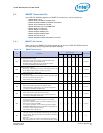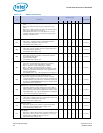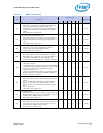
Intel® Solid-State Drive DC S3500
December 2013 Product Specification
328860-002US 25
Example Use Cases
The Timed Workload Endurance attributes described in this section are intended to be
used to measure the amount of media wear that the drive is subjected to during a timed
workload.
Ideally, the system that the drive is being used in should be capable of issuing SMART
commands. Otherwise, provisions have been provided to allow the media wear attributes
to be persistent so the drive can be moved to a SMART capable system to read out the
drive wear attribute values.
Use Case 1 – With a System Capable of SMART Commands
1. On a SMART capable system, issue the SMART EXECUTE OFF-LINE IMMEDIATE
(D4h) sub-command 40h to reset the drive wear attributes.
2. Run the workload to be evaluated for at least 60 minutes. Otherwise the drive
wear attributes will not be available.
3. Read out the drive wear attributes with the SMART READ DATA (D0h) command.
Use Case 2 – With a System Not Capable of SMART Commands
1. On a SMART capable system, issue the SMART EXECUTE OFF-LINE IMMEDIATE
(D4h) sub-command 40h to reset the the drive wear attributes.
2. Move the drive to the system where the workload will be measured (and not
capable of SMART commands).
3. Run the workload to be evaluated for at least 60 minutes. Otherwise the drive
wear attributes will not be available.
4. Do a clean system power down by issuing the ATA STANDBY IMMEDIATE
command prior to shutting down the system. This will store all the drive wear
SMART attributes to persistent memory within the drive.
5. Move the drive to a SMART capable system.
6. Read out the drive wear attributes with the SMART READ DATA (D0h) command
within 60 minutes after power-up.
Example Calculation of Drive Wear
The following is an example of how the drive wear attributes can be used to evaluate the
impact of a given workload. The Host Writes SMART attribute (E1h) can also be used to
calculate the amount of data written by the host during the workload by reading this
attribute before and after running the workload. This example assumes that the steps
shown in “Example Use Cases” on page 18 were followed to obtain the following attribute
values:
• Timed Workload Media Wear (E2h) has a raw value of 16. Therefore, the per-
centage wear = 16/1024 = 0.016%.
• Timed Workload Host Read/Write Ratio (E3h) has a normalized value of 80, in-
dicating that 80% of operations were reads.
• Workload Timer (E4h) has a raw value of 500. Therefore the workload ran for 500
minutes.
• Host Writes Count (E1h) had a raw value of 100,000 prior to running the workload
and a value of 130,000 at the end of the workload. Therefore, the number of
sectors written by the host during the workload was 30,000 * 65,535 =
1,966,050,000 sectors or 1,966,050,000 * 512/1,000,000,000 = 1,007 GB.
The following conclusions can be made for this example case:


















